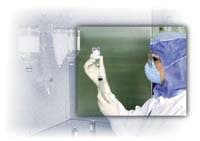EYE ON EQUIPMENT
Processing special needs
eyewear
By Susan P. Tarrant
When a patient comes in requiring special eyewear, it can be a challenge to fill those needs in-house. Obviously, keeping the job in-house is a testament to the type of quick turnaround and customer service dispensers want to be known for. But it also betters your bottom line, as it represents one less job that needs to be turned over to an outside lab, or a patient that doesn�t have to be turned away because your dispensary can�t handle the request.
Our experts are here to offer advice on how to deal with these requests.

PROBLEM: When offering lenses for safety wear or sports protection, we are concerned about following ANSI regulations. Are there particular processing regulations?
SOLUTION: Safety lenses require a different type of bevel, according to ANSI standards. The angles of the bevel are different from those of dress eyewear, and it�s important to keep that in mind when edging. They�re angled differently so that, in the case of an impact, the lens would fall away from the face instead of toward the eyes.
To get that angle, the job needs to be done with a different angled diamond wheel. Always refer to the ANSI standards before starting any safety job. Wrap-around frames, whether they are for sports or for light-intensive jobs, also present an angling challenge.
If not angled properly, you�d get a lens with a bevel that would allow an optician to insert the lens, but it would be prone to popping out. Using a 3-D patternless edger could be your answer, as it would be able to follow the curves of the frames much better. You must be careful that you have ordered the correct base curve of the lens�it must match the base curve of the frame.
However, sometimes even that won�t work, especially if the eyewear has such a dramatic base curve that the lens needed for the Rx just won�t match. In cases like that, it�s important to be able to communicate the problem to the patient and encourage him or her to pick a frame with a less dramatic base curve.
�Matt Vulich, vice president, sales and marketing, AIT Industries
Occupational Advice
PROBLEM: What are "overhead" occupational lenses, and are they difficult to do in-house?
SOLUTION: If someone needs to read over his/her head (such as postal workers reading box numbers, hospital techs looking at raised equipment, pilots reading instruments, or painters doing close tedious work above their heads) their are options.
Occupational lenses come in many forms. Some examples are:
- D segs (25, 28 or 35 mm) or straight tops at both the bottom and the top of the lens with a 14 mm distance between the segs for distance vision.
- Quadrifocals, where there is a trifocal at the bottom and a D seg at the top. This would be for those who need intermediate vision as well as near.
- There is also a progressive that has an ultex or large round seg at the top.
- There are double seg executives where the distance between the lower and uppers seg is 14 mm.
- There are round 25 mm double segs with a 14 mm distance between segs.
The key with fitting these types of lenses is to measure for the lower seg to be in its normal position and the upper seg will fall into place. It is in a fixed position relative to the lower seg.
There have been some cases where the customer has requested just a bifocal in the upper portion of the lens and not in the lower. A conventional bifocal can be used (D seg or round seg) and the surfacing would require that the lenses be turned upside down. In the case of D segs, it would be necessary to use the right lens as a left and vice versa.
�Stuart Watson, director of training, National Optronics

PROBLEM: We want to accept a large job of creating Rx�d safety goggles, but are not sure that we can do it on our in-house equipment.
SOLUTION: We have developed quite a talent for creating safety goggles, sometimes under extreme situations. We are a sponsor of the Special Olympics and create eyewear for any athlete in need that day, as well as safety goggles with polycarbonate lenses. All are done on-site.
The fact that the goggles have a larger size and greater base curve than dress eyewear often prevents them from fitting nicely into the tracers. Furthermore, the large nose piece of the goggles often stops the tracing stylus, making it even more difficult. So we just trace one side and use the mirror image for the other side.
Sometimes labs are put off from doing goggles because of the difficulty of inserting the lens. When we are on-site at the Special Olympics, we bring axis adjusters and use them as pliers to "cold snap" the lenses in place. We get lens as aligned as possible, and then use the axis adjusters near the nose piece as pliers to snap the rest into place.
Today�s edging machines are so accurately calibrated that they are matching the bevel and base curve to that of the frame. That, in turn, makes cold-snapping a... well, a snap.
�Rick Noonkester, senior key account manager, West Coast, Santinelli International



